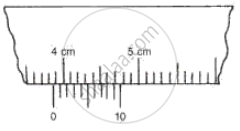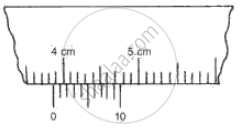Advertisements
Advertisements
प्रश्न
The following figure shows the reading of a vernier caliper used for measuring the thickness of a metal sheet.
(i) Find the least count of the instrument.
(ii) Calculate the thickness of the metal sheet.

उत्तर

(i) 1 MSD = 1 mm
10 VSD = 9 mm
1 VSD = `9/10` mm
Least count = 1 MSD - 1 VSD
=`1/10` MSD
= `1/10xx1`mm = 0.1 mm = 0.01 cm
(ii) Thickness of the metal sheet
Main scale reading = 3.9 cm
Vernier scale division coinciding with main scale = 8
Vernier scale reading = 8 x 0.01 cm = 0.08 cm
Thickness of the metal sheet = 3.9 + 0.08 = 3.98 cm
APPEARS IN
संबंधित प्रश्न
The wavelength of light of a particular colour is 5800 Å.
Express it in metre.
What do you mean by zero error of a screw gauge? How is it accounted for?
The pitch of a screw gauge is 1 mm and the circular scale has 100 divisions. In measurement of the diameter of a wire, the main scale reads 2 mm and 45th mark on the circular scale coincides with the base line. Find
(i) The least count and
(ii) The diameter of the wire.
Define metre according to the old definition.
When does a vernier callipers has the negative error?
How do you account for positive zero error for calculating the correct diameter of wires?
